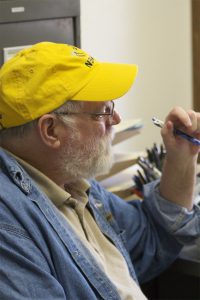by Katherine Kiefer
The plight of the honey bee has national attention, now can our political process really “Give Bees a Chance?” There are a few baseline assumptions to help us all understand these threshold issues. The issues I see are:
1. Political action is always human – humans with varying degrees of experience, education and other biases. Political activity always, ALWAYS has an agenda and an outcome of preference.
2. It is important to recognize that there is a well-funded campaign at all levels of government land management, to eradicate certain invasive plants. Many of these plants are key sources of pollen and nectar for honey bees. Implementation of this policy results in the loss of natural, unadulterated habitat for bee forage.
3. Having a clear understanding of the total volume of land and attendant bloom to meet food requirements for a colony of bees north of the frost line in the continental U.S. To support current levels, these lands and bloom sources cannot be reduced.
4. Human beings, whether beekeepers, farmers, Extension Services Staff or politicians, make every day decisions which impact their natural environment.
To thrive, that is produce brood and honey, bees need continuous forage that is safe for them – what you have is knowledge of beekeeping practices in the places where you keep bees. What we intend to unlock are phrases, practices and outlines for actions that you can take to change the policies, which are a result of the politics, surrounding forage plants and colonies of honey bees. In this first article, we – beekeepers and policymakers – need to set as a priority the protection of pollinators from policies which seek to destroy important honey plants.
Currently, there is a movement – politicized – against non-native plants. In my part of the world, where I am a Selectman – part of the three person governing board of my Town in Southern New England – Salisbury, Connecticut – there is pressure on committees in the Town from well meaning residents. Governments, local, county, state and Federal, manage large tracts of land throughout the country. This is where citizens and residents have traction – political traction. Town Planning & Zoning Boards in Connecticut (Connecticut has no counties) have almost exclusive power to control the land use within their borders. This is the political world where individuals have impact. In this world of discussions, decisions and open meeting laws, this is where the world is run by those who show up. There is pressure for us, in my local government, to eradicate non-native plant materials, and if the plant is invasive and aggressive, the pressure increases. Our local beekeepers need to (a) know about these plans, and (b) challenge the plans that are seeking to destroy honey plants.
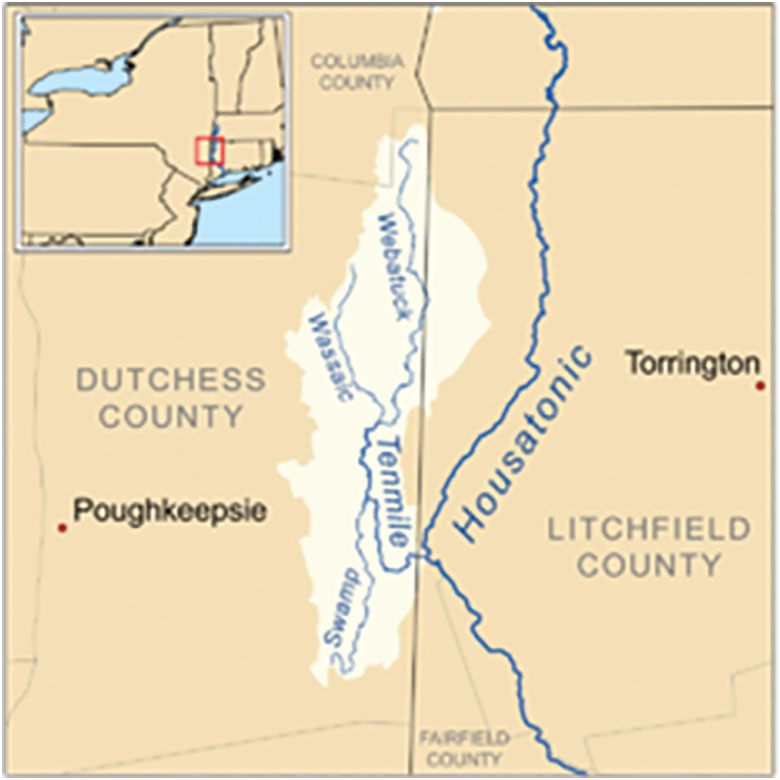
When I was first elected, I attended a Ten Mile River, Watershed Management meeting (6/7/2014) – the two states in this watershed are New York and Connecticut. I wanted to listen and see how the issues were presented by the various groups – a partial list of presenters: Housatonic Valley Association, Cary Institute of Ecosystem Studies, U.S. Army Corps of Engineers, Dutchess County Soil and Water Conservation District, Cornell Cooperative Extension of Dutchess County, NY State Department of the State Office for Planning and Development. The presenters had studies and plans for controlling and managing this watershed. The attendees were from the Towns in the two states in the Watershed – Planning boards, Conservation Commissions, Water Commissions and council members and selectmen. The presented purpose, as it evolved, was to encourage all the small towns present to apply for grant money to act within the plan that the presenters involved had for the land area. These towns are largely served by volunteers, all local of course, and the presenters were largely entrenched bureaucrats with degrees, salaries and influence. The locals, eager to explore the possibilities for grant money, tried to understand what the bureaucracies deemed “priority actions.”
Honey/nectar producing plants around here, by season, include: dandelion, tulip poplar, basswood, willow, loosestrife, aster, goldenrod, spotted knapweed, glossy buckthorn, sweet clover and sumac. There were no beekeepers at this meeting, and there were no advocates for honey bees or pollinators in general. The presentations and discussions focused on watercourse construction, public access, and species eradication. I must admit that I have a bias toward and for honey bees, so I was shocked that “a benefit to changing drainage would be discouraging purple loosestrife.” I raised my hand and brought out many of the points I am raising here.
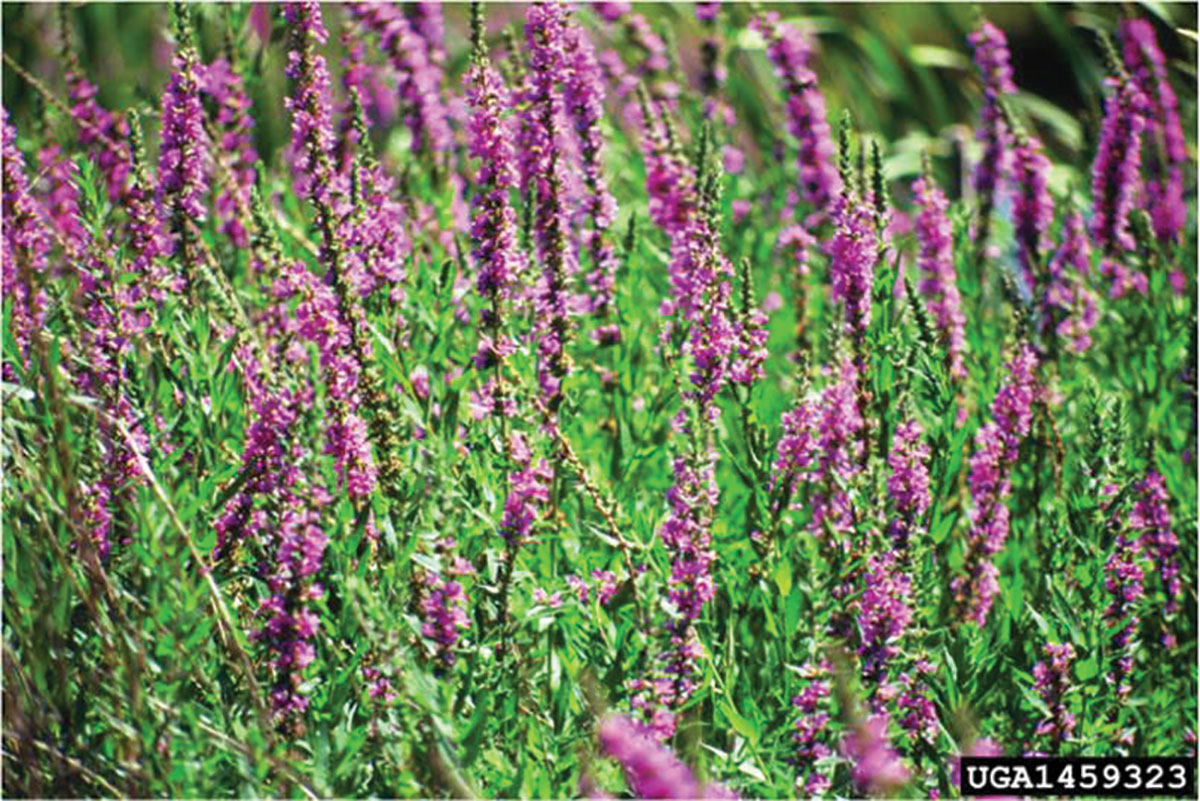
Loosestrife.
I, in Salisbury, Connecticut, started 10 colonies of bees from nucs. They did great from dandelion through the end of basswood bloom. There was lots of tree pollen and tulip poplar bloom for the colonies, but after basswood, there was not enough naturally occurring bloom, not enough loosestrife, not enough Joe Pye weed, or goldenrod, aster. And not enough spotted knapweed nor Japanese knot weed. No nectar. I had to feed. I got a few frames of honey, and only two colonies had enough to live through the Winter.
Bee facts and Numbers
A colony, from January 1 through December 31 needs 44-88 pounds of pollen (depending on quality, weather, etc.) and 150 pounds of honey (including that needed to make wax) to thrive – make the necessary brood and to collect all that they need to survive the year. Honey harvested for human consumption is above this base number of pounds for colony health, so for this example we are pulling a 55 pound average. Total requirement per colony per year is 205 pounds of honey. The general ratio of nectar to honey is 32mg of nectar yields 17mg of honey (Canadian Honey Council “How to Make a Pound of Honey”). This is dependent on weather and the nectar source. Bee math – one ounce has 28,350 mg in it. To make 205 pounds (76,586,435.763mg) of honey, the bees need to collect 92,988,000 mg of nectar. Each worker bee, weighing about 80 mg herself, can carry about 70 mg of nectar in the honey sac. So, per colony, about 1.5 million bee honey sac loads of nectar are needed annually. About 100 flowers nectar yields 17mg of honey, so 2.6 million flowers yield one pound of honey. So, to make 205 pounds of honey, workers must make 533 million flower visits. This quantity is not in your neighbor’s “Bringing Nature Home” flower planting. (also Hive and the Honeybee, Dadant, 7th printing of 1992 edition, Honey Bee Nutrition, Ch.6)
A bee can fly about 2.5 miles from her hive, which is a circle five miles in diameter = 23.75 square miles X 640 = 15,200 acres. Average commercial beeyard has 60 colonies. For this fly zone there MUST be more wildness than say, corn, or pavement, or flower gardens, or hay fields or forest.
An important component of modern large numbers of bees in beekeeping is having natural environments large enough for the bees to survive. Large environments. Fields of bloom with good nectar and pollen. Since most tillable acreage is in row crops how many acres of volunteer weeds, non-native and native like goldenrod does it take to support the New York State beehive population? So, what can be done to preserve habitat, healthy habitat, for honey bees? And what do bees actually need? These questions need answers.
On March 4th 2015 H.R. 1264, the Pollinator Protection Act, was introduced to the committee on agriculture. Broadly, this Bill called for the suspension of the registration of certain insecticides, along with creation of a plan to monitor native bee populations.
This Bill did not make it out of committee. In June 2015 The National Strategy To Promote The Health of Honey bees and other Pollinators also known as The Pollinator Health Task Force was introduced by President Obama to achieve the following goals:
• Reduce honey bee Winter mortality from 30% to 15% within 10 years,
• Increase the eastern population of monarch butterflies to 225 million,
• Restore or enhance seven million acres of land for pollinators over the next five years.
This Federal Order calls for planting seven million acres across the nation of a pollinator “friendly” mix. The focus for this plan is in the central part of the country because most of the managed bee colonies spend their Summers there – on sweet clover.
Members of the Xerces Society wish to focus on pushing toward native plants rather than sweet clover (and star thistle and spotted knapweed). Sweet clover is probably the most productive honey plant in America. In the December 2015 issue of Bee Culture, the cost for the “pollinator mix” is given as $400 per acre versus $15 per acre for sweet clover. To spend $2.8 billion dollars on the seed for this project, without including the cost to prepare of the land for planting, or the resources spent doing the planting is unrealistic. If the Xerces Society continues unopposed with this plan, the attention of all interested in the plight of the honey bee will be focused on a non-solution AND there will be an incredible waste of resources. The goal needs to be preserve, protect, support the honey bee, not to support a not-for-profit interested in planting an artificial mix of plants while eradicating the very plants that bees love.
Another political agenda which evolved out of the presidential directive, was the creation in New York State (as in all states) of a pollinator task force. This occurred in April of 2015. The surprising thing to me was that of the 12 member advisors, only two were beekeepers. There were three representatives to represent pesticide interests, three seats given to agriculture – farm bureau, fruits and vegetables, three were NGOs and the co-chairs NYSDAM (New York State Department of Agriculture and Markets) and NYSDEC (New York State Department of Environmental Conservation). Only two beekeepers? And this group seems to be focusing primarily on pesticides as a necessary component of agriculture. The group has not been called to meet again, yet.
But what about bee forage? How do we protect enough bee pasture to support NY State’s 80K colonies? An important component of modern large numbers of bees in beekeeping is having natural environments for the bees to forage. Large environments. Fields of bloom with good nectar and pollen. Without pesticides.
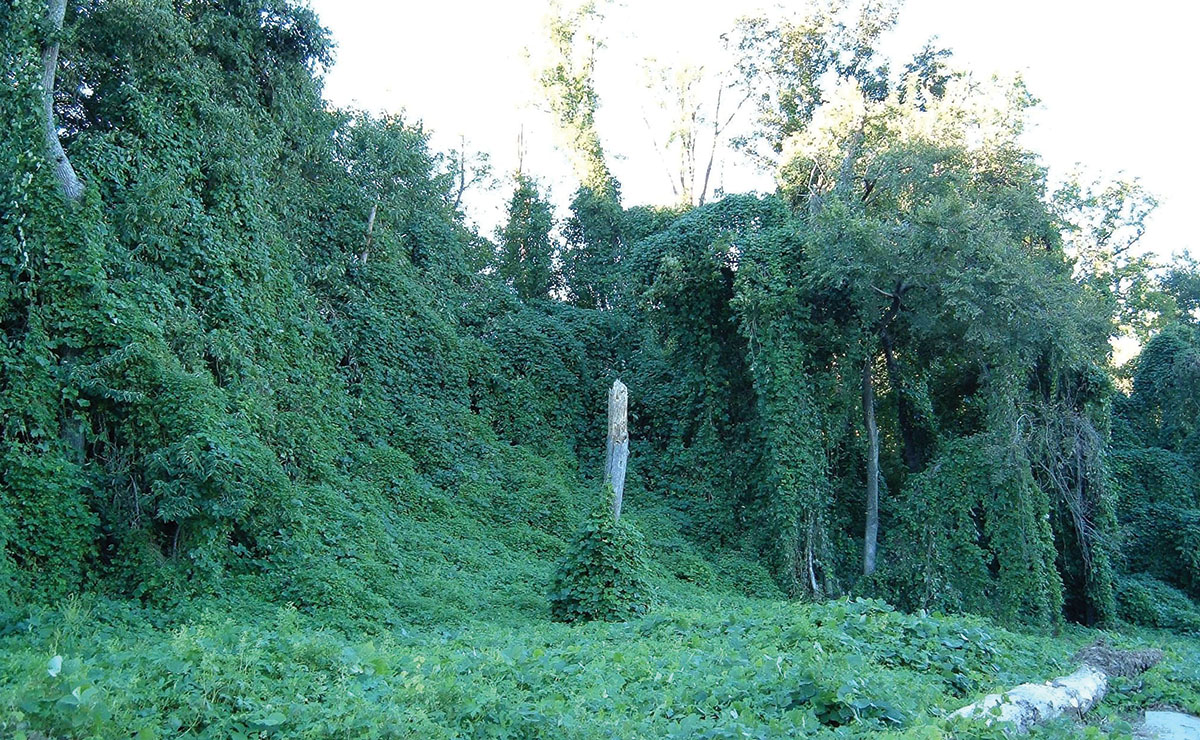
Kudzu.
To understand the scope of the attack on non-native invasive plant species, you need only to “Google” invasive, non-native plants. When doing so you’ll find most states with long lists of plants considered invasive along with elaborate plans to eliminate them. Minnesota has a common approach to what it defines as ‘Noxious Weeds’ – go to mda.state.mn.us – the bee forage targeted is – brown knapweed, yellow star thistle, meadow knapweed, spotted knapweed, purple loosestrife, knotweeds, Canada thistle & glossy buckthorn. The plans for eradication include mowing, removing them by the root, the introduction of insect predators, and in most cases remedies soon digress to poison with any of several herbicides. Two problems (1) the eradication process means a year or two of no bloom of anything, then (2) at least one more year while the introduced “natives” are growing and maturing.
Honey bees, also, are not native to this continent. The plants that they super pollinate, sweet clover, star thistle, spotted knapweed, purple loostrife – have bumper seed crops every year, and become more and more prolific, forming healthy populations. Beekeepers depend on these large tracts of wildness, with the bloom of these deemed noxious pests, and return year after year to place their bees in these wonderful locations.
Who gets to define invasive non-native? What list of native plants do we use as the source for the consternation? Plant native here in 1603? Before any European Settlements? The world is not the same – the species currently in the continental USA include “all the birds of Shakespeare” released in Central Park in 1890 and 1891. Eugene Schieffelin (member of the American Acclimatization Society) purposely introduced English sparrows (a.k.a. house sparrows), starlings, magpies, and other European birds that failed to become “invasive non-natives.” But starlings and English sparrows are successfully suppressing native species. Parakeets, too, in South Florida, are pests.
Who gets to define noxious and who gets license to destroy? In the Ten Mile Watershed meeting, it was very clear that the carrot of grant money was used to give guidance and to influence local government officials. Decisions regarding strategies to mow or spray plant life in roadside ditches or medians, or public parks and public lands are often left to people at the public works departments of local counties or communities. Their decisions regarding which herbicide to use, or whether or not to use manual labor, are often influenced by the chemical salesman or, even more sadly, by individuals, often well meaning citizens who have decided that any and all invasives are somehow dangerous to the environment and must be destroyed.
In many cases where crops are planted “fencepost to fencepost” the only food sources not tainted by systemic pesticides and fungicides are the invasive weeds along fencerows and hedgerows. Indeed most non-crop pollinator forage is “volunteer” occurring in gullys, steep hillsides or wetland swales. Local Conservation Commissions and Inland Wetlands Commissions need to not believe all that they hear from the U.S. Army Corps of Engineers. The importance of the preservation of these plant stands cannot be overstated.
As beekeepers, either as individuals or at the club level, we need to make our local public aware of the dichotomy between beneficial invasives and non-beneficial invasives.
We need to create a list of the plants that cause us to choose locations for our colonies, remembering that honey bees fly up to 2.5 miles from the hive. We will thus at the same time provide an explanation of why these plants must be protected. As beekeepers we should always oppose the application of herbicides to the environment anywhere.
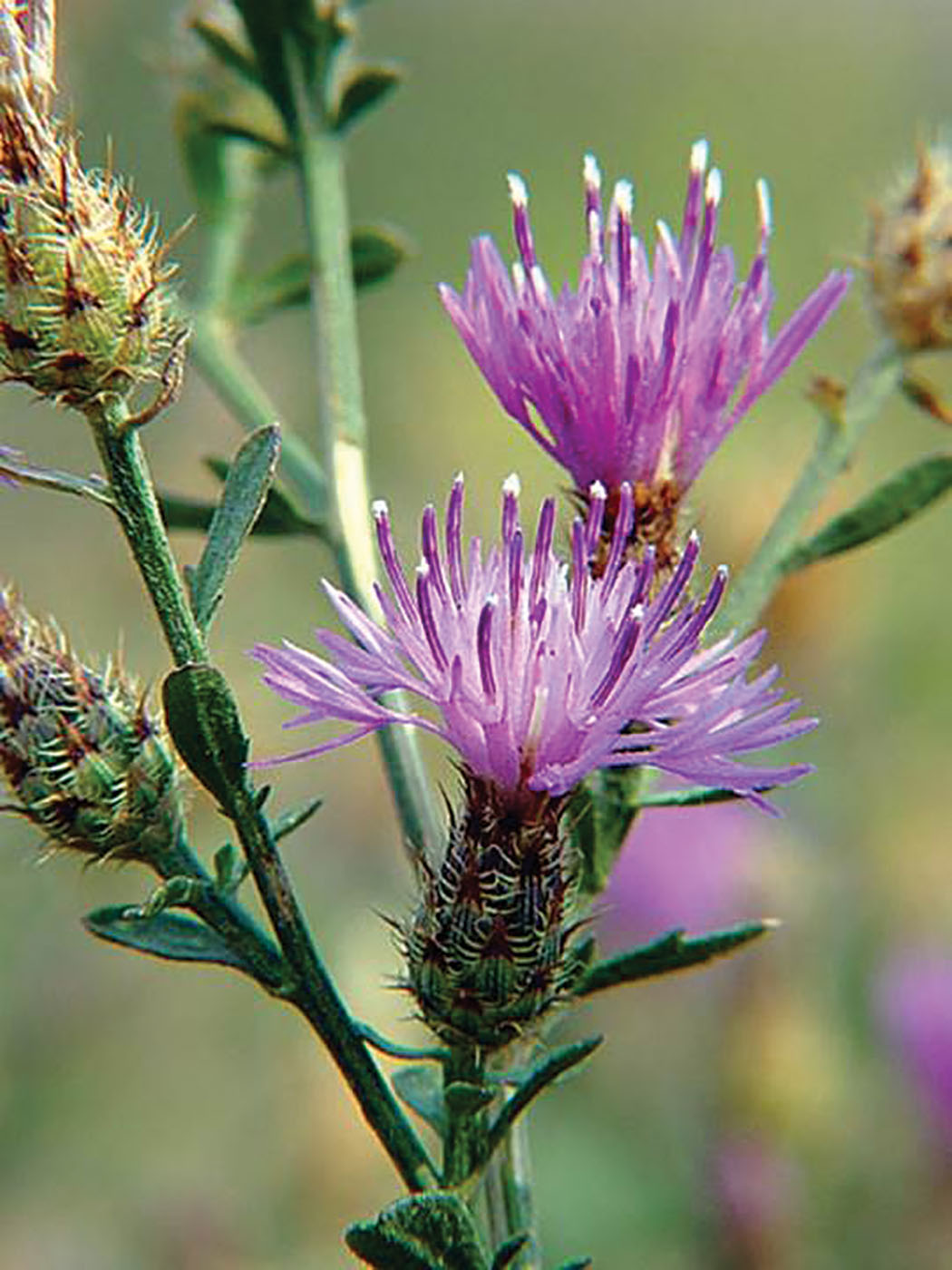
Spotted (purple) Knapweed.
Finally, we need to educate people of the importance of preserving these plants in large quantities as essential diverse food sources of all pollinators through open meeting discussion, news outlets and social media.
Returning to Saving America’s Pollinators Act of 2015; it has not yet passed. But the Bill has words that pretty accurately describe the loss percentages experienced among beekeepers large and small. It clearly states: one third of all crops produced in the U.S. require honey bee pollination services, and it further states, “according to scientists at the Department of Agriculture, current losses of honey bee colonies are too high to confidently ensure the United States will be able to meet the pollination demands for agricultural crops.”
Hobby beekeepers, as important as we are, cannot provide this necessity for agriculture. But what we can do is advocate for habitat for all bees, and other pollinators. But honey bees must be the focus.
Commercial beekeeping, or any beekeeper with more than 20 colonies knows that the secret to success is, Location, Location, Location. The best honey and the healthiest bees come from places unadulterated by humans – where the plants have gone wild.
From Thoreau’s essay, Walking “…and what I have been preparing to say is, in wildness is the preservation of the world.”
I’ll talk politics and chemicals next time.
Please contact me, Katherine Kiefer beesweet1@gmail.com – Let’s work together.







